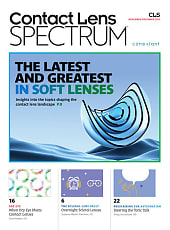New Dispenser/{ frame TIPS }
Frame Fitting Tips
Groomed for Success
BY KARLEN McLEAN
Sometimes you have to think and adjust differently to achieve the best frame fit and lens performance. Here, veteran opticians share top frame-fitting tips—ones that aren’t necessarily found in the instruction manuals.
TRICKS OF THE TRADE
Those who have been on the front lines don’t mind using whatever tools they can access to do their best work—even if that means using household items to finish a project. “Seal every eye wire screw with clear nail polish at final adjustment. This helps save lenses from falling out, and the seal is easily broken if needed to replace a lens,” says Dianna Finisecy, ABOC, president of Wagner Opticians in Washington, DC. “Even the best quality eyewear can have screws that back out. It’s inconvenient and looks unprofessional to patients.”

Working with what you’re given, but in a different manner than the original design, can create fitting improvements. Most adjustable nose pads are placed so they’re narrow at the top and wider at the bottom. When there’s extreme discomfort with nose pad pressure on the bridge, try inverting the pads so they’re wider at the top (upside down). This can help relieve pressure.
LENS LESSONS
Roxanne Harless, ABOC, NCLC, dispensing optician at Andersen Eye Associates in Saginaw, MI, notes that every frame doesn’t suit every prescription. “Discuss the customer’s Rx and lens style before selecting frames. Know what type of lens and lens material will be used so that you can recommend the best frames choices.”
Making base curves work is an important consideration, she adds. “Make sure that the frame can be curved to match necessary lens base curve. Several newer metal frame styles are designed with the actual eye wire behind a flat front metal piece. Higher plus powers will not fit well in this type of design.”

LAB ENLIGHTENMENT
An optical laboratory tends to look at frame fitting from a lens point-of-view. Here are lens-logical frame fitting tips from Glenn Herringshaw, former director of the optical lab at the Indiana University School of Optometry in Bloomington, IN.
Start out with a properly fitting frame, taking into account the:







It’s also beneficial to know the lab’s method for determining optical center (OC) placement. My preference is to have the OC of:


With larger frames making a comeback, it’s important to know:

In the case of special function glasses such as for golf or computer use:




